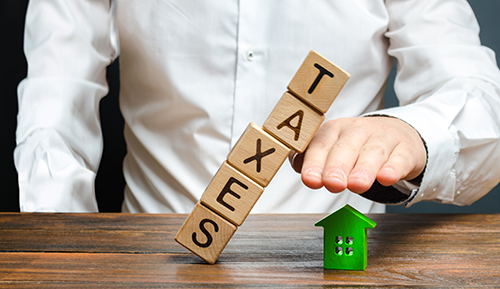 The sale of a primary residence can often result in a gain, resulting in a taxable event of a 20% capital gain rate, and if you are a higher income earner an additional 3.8% for net investment income taxes. The gain is the positive difference between the purchase price of the primary residence and the sale price.
The sale of a primary residence can often result in a gain, resulting in a taxable event of a 20% capital gain rate, and if you are a higher income earner an additional 3.8% for net investment income taxes. The gain is the positive difference between the purchase price of the primary residence and the sale price.
The Internal Revenue Code 26 U.S.C. §121, excludes from gross income the gain from the sale or exchange of property if, the property was used as the taxpayer’s primary residence for 2 years during a 5-year period.[1] The exclusion of gain cannot exceed $250,000 for those filing single, and cannot exceed $500,000 for those married filing jointly. [2]
A taxpayer will be automatically disqualified for the exclusion if they acquired the property through a like-kind exchange (Code Section 1031 exchange), during the past 5 years; or the taxpayer is subject to expatriate tax (persons who are not a tax resident in the USA). [3]
To qualify for the primary residence exclusion, the taxpayer is required to meet a two-prong test which proves ownership and residence. The first prong is the ownership test, it requires the taxpayer to have owned and used the home as a primary residence for at least 2 years out of the last 5 years leading up to the date of sale, or date of closing.[4] For married filing jointly taxpayers, only one spouse must meet the requirement. [5] For example, Michael files married filing jointly and lives in a mobile home for Years 1 and 2, his spouse “Stephanie” lives in a separate residence. Michael moves to live with Stephanie for Year 3 through Year 5. In Year 5, Michael decides to sell his mobile home. He meets the ownership test because only one spouse has to live in the mobile home as their primary residence for 2 years out of a 5-year period. However, to be eligible for the exclusion Michael and Stephanie must meet the second prong of the test.
The second prong is the residence test, it is based on facts and circumstances proving the home was the primary residence of the taxpayer(s). Unlike the ownership requirement, for married filing jointly taxpayers both spouses must prove this test (only one is required to prove the ownership test). Facts that prove primary residence include:
- a) the address listed with the U.S. Postal Service;
- b) voter registration card;
- c) federal and state tax returns;
- d) driver’s license or car registration; and
- e) if your residence is near where you work, bank, other family members, or recreational and religious organizations of which you are a member.5
The use of a primary residence does not need to be consecutive, only a cumulative of 730 days (2 years) in total. id. For example, using the fact pattern above, Michael lives in his primary mobile home for two years. He moves to live with Stephanie in another residence for Year 3 through Year 5. Michael lists his mobile home as his primary address with the U.S. Postal Service, works 15 miles from the mobile home, banks in the local area, and files his tax returns under the mobile home address. Stephanie spent weekends (Friday, Saturday, and Sunday), holidays, and vacations at the mobile for the last five years, she attends church with Michael near the residence, has a local library card, files tax returns with Michael, she is a joint owner of the local bank account, and her driver’s license is registered under the mobile home address. Michael and Stephanie will likely qualify for the primary residence exclusion, not to exceed $500,000 on the sale of the mobile home. In this example, Michael has met the ownership test and the residence test, he has spent more than 2 years (730 days) in the mobile home, he works near the residence, the U.S. Postal Service and the tax returns are filed under the address, and he has a local bank account. Stephanie will likely also meet the residence test, she resides in the mobile home for more than 730 days for a 5-year period through her stays on weekends, holidays, and vacation, she attends a local church, her driver’s license and tax returns list the residence address, and she has a local bank account. Michael and Stephanie will likely qualify for the primary residence exclusion, not to exceed $500,000, as married filing jointly filers.
The primary residence exclusion has limitations, called a look-back requirement and can only be used once if more than one primary residence was sold during a 2-year period. id. For example, Michael lives in his primary residence, a mobile trailer, for Year 1 and Year 2. Michael and Stephanie purchase a condo in Year 3 and use it as their primary residence for the next two years. They decide to sell the mobile home in Year 5 and use the primary residence exclusion from the gain of the sale. In Year 6, Michael and Stephanie sell their condo and have a large capital gain. They are not able to claim the exclusion on the condo, because Michael and Stephanie utilized the exclusion on the mobile home within a 2-year period.
To qualify for the primary residence exclusion, it is important to meet both the ownership and residence requirements. Planning for the sale of a primary residence and knowing the facts can make a large deduction from your gross income and help you save taxes.
[1] 26 U.S.C. §121(a)
[2] 26 U.S.C. §121(b) (1) (2) (A)
[3] https://www.irs.gov/publications/p523
[4] 26 U.S.C. §121(a)
[5] https://www.irs.gov/publications/p523
